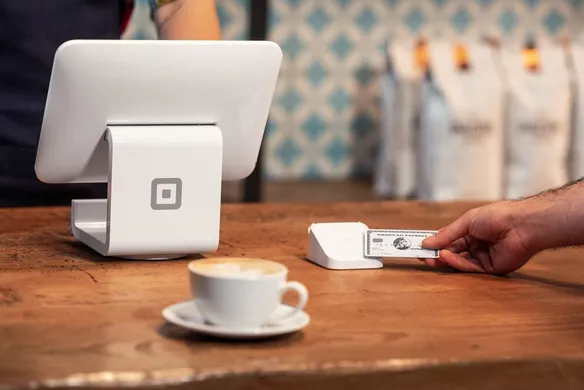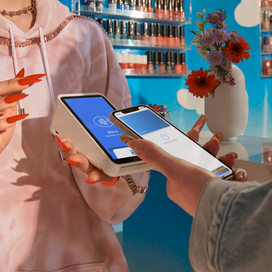Table of contents
Intro to Credit Card Processing
You don’t need to know the ins and outs of card payment processing to own and operate a business. But it definitely helps to understand the basics. In this guide, we walk you through everything you need to know about credit and debit card processing – and how to select the best option for your business.
Four Frequently Asked Questions About Credit Card Processing
1. What is a credit card processing company?
A credit and debit card processing company (like Square) handles credit and debit card transactions for businesses.
2. How does credit card processing work?
Credit and debit card processing involves several parties. These include issuing banks, acquiring banks, payment networks and the merchant services provider.
3. How much are credit card processing fees?
Square’s pricing is simple – 1.6% for in-person card and contactless payments. The fee for manually entered card-not-present transactions is 2.2%.
4. How can I accept credit card payments?
To accept in-person credit card payments, you need a card reader or terminal. Square’s popular Reader is just $65 and accepts all major credit and debit chip cards and contactless payments. If you don’t intend to sell from a physical location, you can also take a look at Square Online which makes it easy to securely accept card-not-present payments.
What is credit card processing?
Taking a credit or debit card payment may seem simple enough. A customer takes out their card, it’s processed, and with Square, the money usually lands in your account within one to two days. But if you look closer, there’s a lot more going on. From the time you swipe or insert the card until the time the money is deposited into your bank account, there are a number of different parties involved. And each of them handles a crucial step in the chain of events. Having a general knowledge of how credit card processing works helps you understand where you might incur fees – and informs your decision about which card processing system makes the most sense for your business.
The parties involved in credit card processing
Let’s say you go into a place called Cafe del Sol and pay for a latte. Here are the names of the players who would be involved in the transaction:
- The cardholder: this is the person with the card, buying the coffee (aka you)
- The issuer: the financial institution that provides the card or payment app with your payment credentials on it (e.g. Qantas American Express Ultimate credit card)
- The merchant: the business accepting your credit card as payment for goods or services (Cafe del Sol)
- The acquirer: the financial institution the merchant uses to move funds from issuer to the merchant
- The network: the rails on which the payment will flow (e.g. Eftpos, AMEX, Visa, JCB, & Mastercard)
- The point-of-sale system: the interface used by the merchant to keep track of the transaction
- The EFTPOS payment machine: the hardware used the accept your card payment, e.g. a Square Reader or Square Terminal.
Now let’s zoom in for a moment. There are a few more parties represented on the card and in what’s happening during the transaction itself. They are:
- The issuing bank
- The acquiring bank
- The merchant services provider
Let’s look at each of these in some more detail:
What is an issuing bank?
The issuing bank is the financial institution that provides you with your debit card, or a credit card and accompanying line of credit. In other words, it’s your credit card company. Issuing banks act as the middle layer between you and the credit card networks by issuing contracts with cardholders for the terms of the repayment of transactions. For example, your issuing bank could be ANZ.
What is an acquiring bank?
The acquiring bank (also known as a merchant bank or acquirer) is the bank that sends the transactions to the network, which then passes it on to the issuing bank.
What is a merchant services provider?
A merchant services provider is an entity that allows businesses to accept payments by credit card, debit card, and also NFC mobile wallet (like Apple Pay or Google Pay). A merchant services account is established with an organisation that has relationships with the issuing and acquiring banks. Your merchant services provider allows the processing of electronic payments when your customers want to pay for things.
What about online payments?
Say Cafe del Sol had an online store to sell things like clothing and coffee mugs. Something called a payments gateway would be involved in processing those online card transactions. A payments gateway allows for the transfer of information between a payment portal (like a business’s website) and the acquiring bank. It encrypts sensitive information like card numbers to make sure everything is secure throughout the process.
Merchant credit card processing
How do you get a merchant services account?
Typically, if you wanted to start processing credit and debit cards, you’d apply for a merchant services account at a bank, which can be a cumbersome process. After you were approved, you would then have to wait for the bank to send you a payments terminal before you could start accepting cards.
But with Square, things work a little differently. Square itself has a merchant services account with acquiring banks. We essentially act as one large merchant services account for all businesses that use Square. And you can order a payments terminal online with fast shipping, or go pick it up from a retail store to start taking payments that same day.
What is a high-risk merchant services account?
In the credit card processing world, some types of businesses may be considered “high risk” for a wide variety of reasons. High-risk merchant services accounts can have steeper fees and stricter terms. Institutions such as major banks may also prevent high-risk merchants from creating an account.
There’s no hard rule, but certain types of businesses tend to be flagged as high-risk merchants more than others. These can include businesses that sell goods or services that have risk or legal concerns attached to them (e.g. gambling businesses), and businesses that engage in questionable marketing tactics. Read Square’s user agreement and terms of service for more information.
How does credit card processing work?
Now that we’ve gone through all the parties involved in credit card processing, we’ll walk through how everything actually works. Let’s go back to Cafe del Sol. You tap your card on the EFTPOS machine to pay for your coffee. What happens next?
Here is how the card is processed with Square:
Authorisation
When a customer taps, inserts or swipes their card, the request is submitted to Square. We then send the transaction to the acquiring bank, which then sends it to the issuing bank for authorisation. The issuing bank is checking for sufficient funds. It is also running the transaction through fraud models to determine if the transaction is safe (to protect the cardholder and the issuing bank). This all happens in less than a few seconds.
Batching
This is the settlement stage where the money from a transaction is sent to the acquirer to start the process of depositing it into the merchant’s account. It’s called batching because payments are sent in a large group.
Funding (aka settlement)
The funding (or settlement) step is when businesses get the money from a credit or debit card sale deposited into their bank account. Square’s deposit schedule is usually within one to two business days.
Credit card processing fees
Many companies have heaps of hidden fees when it comes to card processing. These can include transactional fees (like interchange reimbursement fees and assessments), flat fees (like PCI fees, annual fees, early termination fees, account keeping fees and monthly minimum fees), and incidental fees (like chargebacks or verification services).
Square, by contrast, has just one simple, flat fee for in-person transactions (1.6%), and another flat fee for card-not-present transactions (2.2%).
Choose your credit card processing solution carefully, some companies can have hidden fees.
Accepting credit cards
What is a credit card machine?
You need dedicated technology to process credit cards. A credit card machine, aka point of sale (POS), is a device that interfaces with payment cards to make electronic fund transfers (EFTPOS payments). Newer point-of-sale systems such as Square Reader can also accept mobile NFC payments like Apple Pay and Google Pay.
Credit card machine prices
Some credit card machines can cost hundreds of dollars. Square’s latest credit card reader, on the other hand, costs just $65.
Mobile credit card machines
A lot of point-of-sale systems are big and clunky. Square’s POS products are sleek and completely compact. They’re designed to look great on your countertop when you’re selling at your brick-and-mortar shop, and fit in your pocket if you’re selling on the go.
How to set up credit card processing for your small business
If you’re new to all this, or are just starting your first business, getting set up to process credit and debit cards may seem daunting. Luckily, that doesn’t have to be the case. Nowadays, with tools like Square Reader, all you need is your mobile device. Square Reader works directly with the device you already have to accept card payments.
What other types of payments should you accept?
In addition to chip cards, it’s a good idea to also accept NFC mobile payments like Apple Pay and Google Pay. These new payment methods are just as secure as EMV chip cards but can also be a far better customer experience. Whereas chip cards can take a few seconds to process, NFC mobile payments are instant. They’re also picking up steam. 2020 research from Roy Morgan has shown that mobile payments are being used by a growing Aussie cohort – 10.8% of consumers. The more options you can provide your customers for a simple, fast and intuitive experience, the better placed your business will be.
This article is for informational purposes only and does not constitute legal, personal, or tax advice. The information contained herein is subject to change and may vary from time to time. For specific advice applicable to your business, please contact a professional.
1.6% card present rate applies for Square Sellers who sign up on or after 30 May 2024, or who signed up prior to this date and subscribed to a paid software plan. The rate of 1.9% will apply for all other Square Sellers who signed up prior to this date when using Square Reader, Square Stand or Tap to Pay, as listed in the Square Fee Schedule.
![]()











